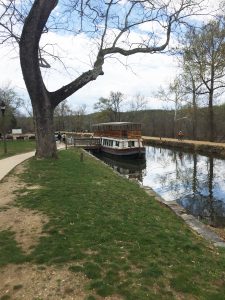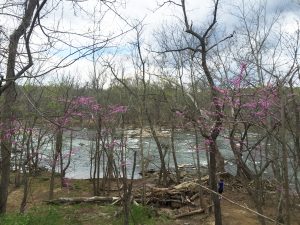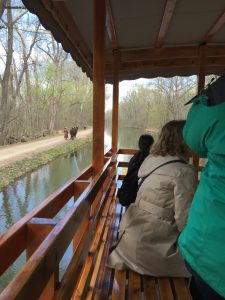
The C&O Canal: D.C.’s hidden gem
POTOMAC, Md.—A narrow, two-lane street winds between columns of oak trees and hills of sun-drenched wilderness. Orange, yellow and crimson leaves are strewn about the cracked, gray cement.
The serene, but inconspicuous, woodland landscape leading up to the C&O Canal makes the Chesapeake & Ohio Canal National Historical Park quite literally a hidden gem.
 |
The peaceful C&O Canal in the Chesapeake & Ohio Canal National Historical Park near Washington, D.C. (Photos by Lee Eisen). |
The average passerby would hardly expect that one of Washington D.C.’s foremost attractions was a mere thousand feet down the road.
“The C&O Canal is America’s best preserved towpath canal,” said a grizzled, blond-haired park ranger who went by the colonial alias Silas Mariner. “Even though the C&O Canal is officially a historical park, we’re also a national and recreational park. We protect 185 miles of Potomac (River) shoreline and we have something like 1,100 historic structures. An astoundingly large amount of architecture is still preserved out here.”
The history of the C&O Canal spans three centuries and runs deeper than the waterway itself.
On July Fourth, 1828, to the sound of applause, clinking glasses and a marching band, President John Quincy Adams broke ground for the C&O Canal. His goal was to create a navigable waterway connecting Georgetown to the Ohio River.
His aspirations proved too lofty.
 |
A view of the Potomac River from the walking trail alongside the canal. |
By the time construction ended in 1850, the canal was far short of reaching the Ohio River. Canals had become obsolete and the Baltimore & Ohio Railroad had completed the link to the West.
Still, between 1828 and 1850, thousands of immigrants found work building the canal.
In the early 1900s, hundreds of families worked and traveled along the canal during America’s westward expansion.
Before children were old enough to work on the canal, parents would chain them to canal boats to keep them from running away or jumping off.
In 1971, U.S. Supreme Court Justice William O. Douglas led a successful campaign to persuade Congress to establish the C&O Canal as a national historical park.
Now, the canal serves as a tourist hub, with hiking trails along the Potomac, bike paths alongside the water, campgrounds, and mule-drawn boat rides.
Yes, boats pulled by mules.
At the Great Falls Tavern Visitor Center in Bethesda, Md., visitors can purchase a ticket to ride a canal boat pulled by four mules, two on each side of the canal.
“Back in the good old days, it was B.Y.O.M., bring your own mule,” said Mariner. “You couldn’t use horses. Horses would just pull and pull until they keel over and die. Mules will stop working after about six hours and demand food and water. Some say the mule’s stubborn, but really they’re just smart.”
At breakneck speeds up to three miles-per-hour, the canal boat is Washington, D.C.’s slowest thrill ride.
But what the ride lacks in wind-whipping speed, it makes up for with the unique experience of being on-board while the boat is raised and lowered in one of the canal’s 74 lift locks.
The lock is like a giant bathtub and the canal boat is like a rubber duck. In order to raise the boat, water is pumped in, and vice versa to lower the boat.
“Being on the canal boat was really fun,” said Elizabeth Iwodu, a freshman at George Washington University. “It kind of felt like I was experiencing a piece of history.”
| The view from the inside of a canal boat. |  |
The canal ride is hardly the C&O Canal’s only hands-on glimpse into colonial life. Visitors can actually stay overnight in a lockhouse.
“We have a program called the Canal Quarters Program where you can spend the night at one of the lockhouses,” said Mariner. “Each one has a different theme time-period-wise and it’s a neat experience.”
Even for the non-history buff, the C&O Canal is a tree-lined pastoral haven for anyone seeking a reprieve from the hustle and bustle of everyday life.
“I came here today to join a painting group,” said Colleen, an older woman who was hauling around enough cases and easels to open up a store. “I love the reflections in the water, and I’m excited to go see the rapids.”
Though the C&O Canal is not on most people’s short lists of must-see historical attractions in the D.C. area, most visitors leave with lasting memories.
“To be somewhere like this, it’s far away from the city where I live, and I couldn’t imagine something like this place exists at all,” said Badara, a middle-aged man who goes by the single name. He grew up in Senegal and currently lives in the Washington, D.C., area. “Even seeing the mules; it was like I’m seeing something happening in another era in history. To just see something like that, for me, was priceless.”
If You Go
There are seven visitor centers along the 185-mile canal.
- Great Falls Tavern Visitor Center (only location that offers canal boat rides): 11710 MacArthur Blvd., Potomac, Md.; 301-767-3714.
- Georgetown Visitor Center: 1057 Thomas Jefferson St. NW, Washington, D.C.; 301-767-3714.
- Brunswick Visitor Center: 40 W. Potomac St., Brunswick, Md.; 301-834-7100.
- Ferry Hill Visitor Center: 16500 Shepherdstown Pike, Sharpsburg, Md.; 301-582-0813.
- Williamsport Visitor Center: 205 W. Potomac St., Williamsport, Md.; 301-582-0813.
- Hancock Visitor Center: 439 E. Main St., Hancock, Md.; 301-582-0813.
- Cumberland Visitor Center: Western Maryland Railway Station, 13 Canal St., Cumberland, Md.; 301-722-8226.
Hours and days of operation vary by season, so please visit www.nps.gov/choh or call for schedules.

Comments are Closed